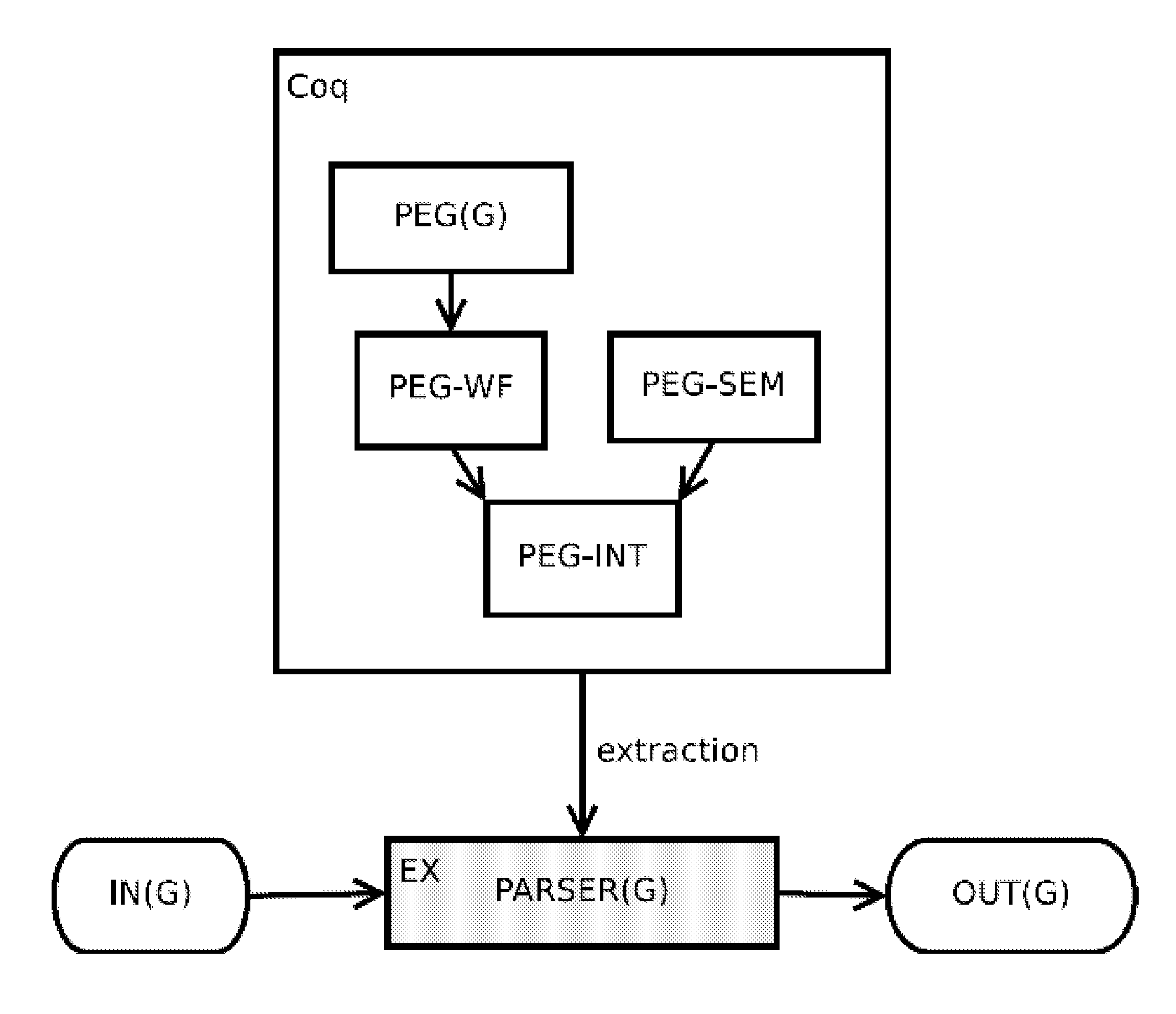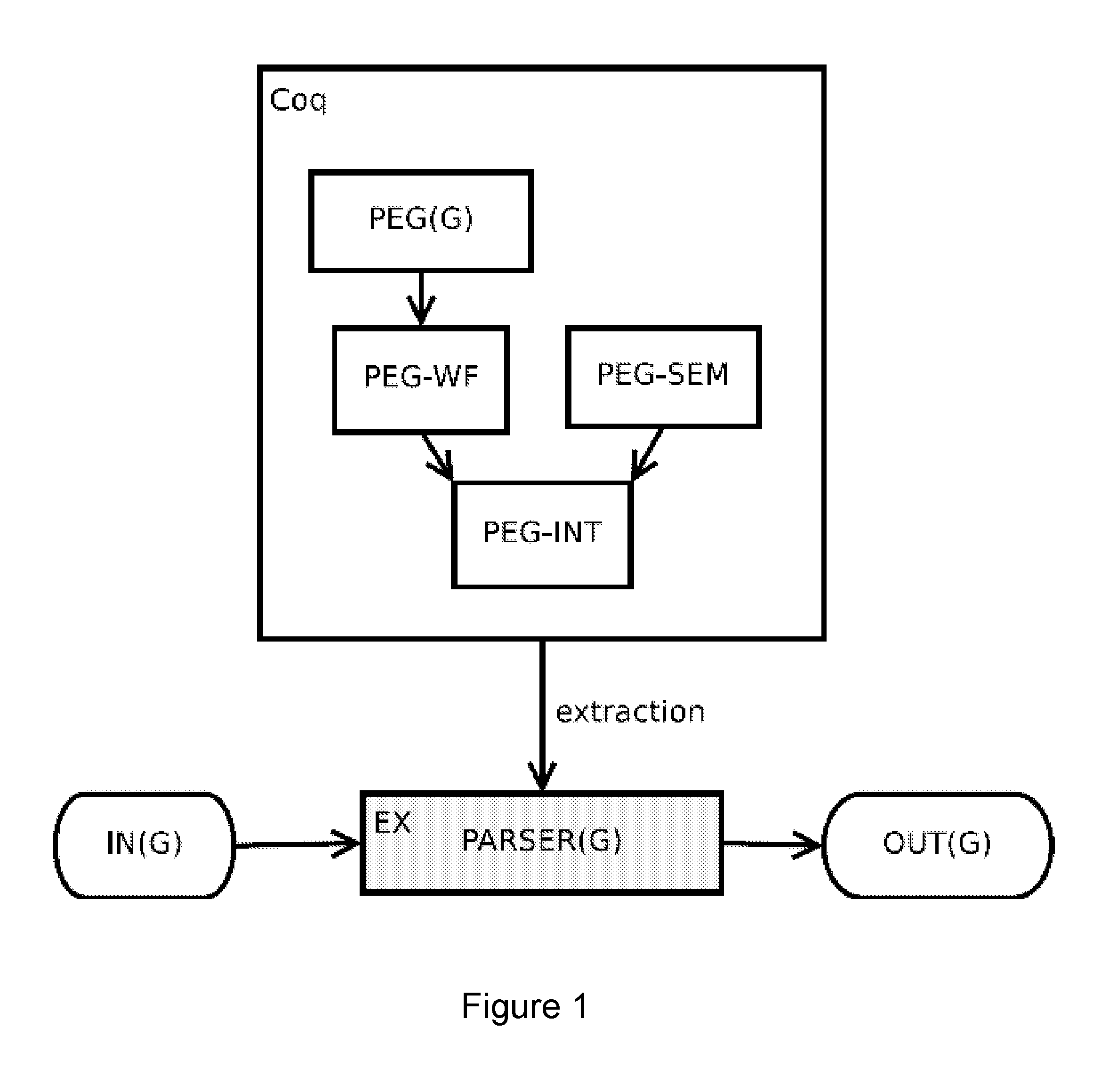System and method for creating a parser generator and associated computer program
a computer program and parser technology, applied in the field of parsing problems in computer science and electronics, can solve the problems of not being able to prove the correctness not being able to prove the formal check of the parser, and not being able to prove the accuracy of the generated parser obtained by prior art techniques, etc., to achieve the effect of improving quality and increasing security
- Summary
- Abstract
- Description
- Claims
- Application Information
AI Technical Summary
Benefits of technology
Problems solved by technology
Method used
Image
Examples
example 1
[0095]As an example let us present a very simple grammar for mathematical expressions with 5 non-terminals and the following productions:
ws::([] / [\t])*
number::=[0-9]30
term::=ws number ws / ws [(]expr[)]ws
factor::=term[*]factor / term
expr::=factor[+]expr / factor
[0096]Here has been described the formalism of PEG which is used as an input grammar in at least one embodiment of the invention. While such this formalism is not one part of the invention, it is important for the disclosure because it helps the skilled in the art to understand the following work which has been
2. Description of Some Embodiments
[0097]In the present section a system / method for creating a parser generator of an embodiment of the invention is presented. Firstly a way to extend PEGs with semantics action is presented and secondly the demonstration for the termination of PEG is given on the basis of some hypothesis, then the use of such a grammar (extended and proved) is shown in an interpreter and in a parser generator...
example 2
[0147]Let us extend the grammar from Example 1 with semantic actions. The grammar expressed mathematical expressions and we attach semantic actions evaluating those expressions, hence obtaining a very simple calculator.
[0148]It often happens that we want to ignore the semantic value attached to an expression. This can be accomplished by coercing this value to I, i.e., e[]λx. I, which we will abbreviate with e[#].
ws ::= ([␣] / [\t] )* [#]number ::= [0-9] + [ ] digListToNat term ::= ws number ws [ ]λ x . x2 / ws [(] expr [)] ws [ ]λ x . x3factor ::= term [*] factor [ ]λ x . x1 * x3 / term expr ::= factor [+] expr [ ]λ x . x1 + x3 / factor
This grammar will associate, as expected, the semantic value 36 with the string “(1+2)*(3*4)”. Of course in practice instead of evaluating the expression we would usually write semantic actions to build a parse tree of the expression for later processing.
2.3 Interpretation of PEGs
[0149]In this section a method and system to obtain a cert...
example 3
[0159]After defining appropriate notations and coercions, the transcription of Example 6 in Coq could look as follows:
Definition prod_type (p : prod) : Type := match p with | ws => True | _ => Q end.Definition char2nat (c : char) : nat := nat_of_ascii c - nat_of_ascii ″0″.Program Definition digListToNat (ds : list char) := let digs := List.map char2nat (List.rev ds) in let fix convert digs := match digs with | nil => 0 | x: :xs => x + (10 * convert xs) end in convert digs.Program Definition production p :=match p return PExp (prod_type p) with| ws =>(″″ / ″\t″) [*][#]| number=>[″0″--″9″] [+][->] digListToNat| term =>ws; number; ws[->] (fun v => A2 v) / ws; ″(″; expr; ″)″; ws[->] (fun v => A3 v)| factor =>term; ″*″; factor[->] (fun v => A1 v * A3 v) / term| expr =>factor; ″+″; expr[->] (fun v => A1 v + A3 v) / factorend.
PUM
 Login to View More
Login to View More Abstract
Description
Claims
Application Information
 Login to View More
Login to View More - R&D
- Intellectual Property
- Life Sciences
- Materials
- Tech Scout
- Unparalleled Data Quality
- Higher Quality Content
- 60% Fewer Hallucinations
Browse by: Latest US Patents, China's latest patents, Technical Efficacy Thesaurus, Application Domain, Technology Topic, Popular Technical Reports.
© 2025 PatSnap. All rights reserved.Legal|Privacy policy|Modern Slavery Act Transparency Statement|Sitemap|About US| Contact US: help@patsnap.com



